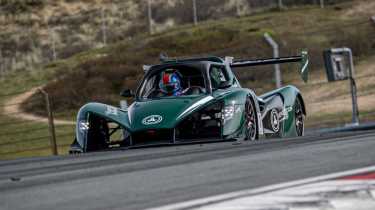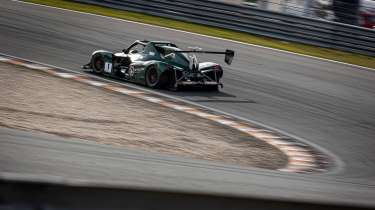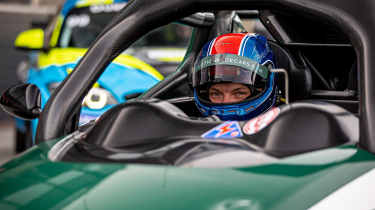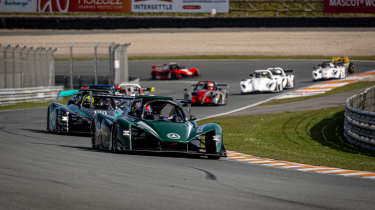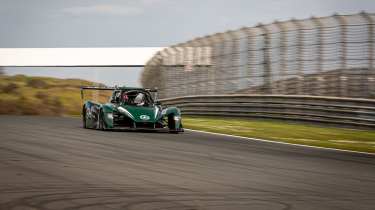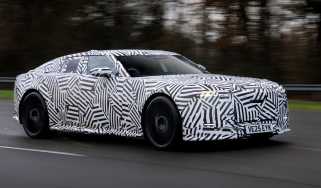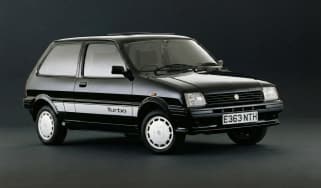F1’s Dutch rollercoaster: What’s it like to race at Zandvoort?
The mildly terrifying Dutch Grand Prix track is truly one of a kind. This is how it feels at first-hand, in a high-downforce prototype
Like me, your eyes may well have been glued to the 2025 Formula 1 Dutch Grand Prix during the weekend just gone. It’s a highlight of the season to watch modern F1 machinery on such an old-school, narrow and undulating circuit. It’s an unforgiving one too, as several drivers experienced during the weekend.
A popular ‘what-if’ conversation is how modern F1 cars would look on a classic circuit as it was in the past – Zandvoort is perhaps the closest we can come to seeing that. Given the track’s layout is built around the topography of sand dunes, it cannot grow the enormous run-off areas of most modern F1-grade circuits.
I watched this year’s race with my eyes even more out on stalks than usual, given this time last year I unexpectedly received a text message from Revolution co-founder and chief designer Phil Abbott, offering the chance to race the supercharged 500 Evo in an endurance racing event called The Trophy of the Dunes. Following the weekend, I thought I’d scribble down some insights on what it feels like to experience the circuit at first hand.
The Trophy of the Dunes is a longstanding event, dating back to the 1960s, with a multi-class formula for GT cars, Touring Cars and prototypes, and a mix of professional, semi-pro and amateur drivers.
Although it’s a round of the Dutch Supercar Challenge, the Trophy is also an invitational event and Revolution has made the journey to Holland successfully since 2022, with back-to-back overall wins that year and in 2023. They were a driver short this time, and wanted to prove the car’s versatility and friendliness in the hands of a non-professional driver with some racing experience. In this case an evo journalist thanking his lucky stars and frantically booking some holiday leave.
evo knows the Revolution 500 Evo well, having tested it during our Track Car of the Year 2024 test where it battled the Radical SR3 XXR and at Anglesey for evo’s laptime leaderboard, where it recorded the fastest time of any car we’ve put a stopwatch against. It’s an innovatively engineered carbonfibre prototype with a 500bhp/410lb ft 3.5-litre supercharged V6 engine, a 608bhp/ton power-to-weight ratio and more than 800kg at downforce above 130mph. Just the ticket for the rollercoaster of Zandvoort, then…
And Zandvoort really is a rollercoaster. The undulations, particularly in the first half of the circuit, include blind crests that must be taken flat out, and a track width that feels awfully narrow when you’re negotiating multi-class traffic. That first half of the track can be traced back to the original 1948 circuit. While it’s not as long as that initial ultra-fast (and even more frightening) layout, it still retains much of the original character.
The circuit was redesigned for modern F1 in 2019, with the Dutch Grand Prix returning in 2021, thanks in no small part to Max Verstappen’s snowballing success. In the process, it gained two rather unique banked corners: one at Hugenholtz, the fourth turn, which was moved back to create more paddock space and given a banking to compensate as well as make it faster. The other is the final Arie Luyendijk curve, given a progressive banking in order to allow F1 cars to drive through it with the DRS slot in their rear wings open.
Thankfully I wouldn’t be driving the Revolution solo, but would be sharing the car with Revolution co-founder and works driver James Abbott. He gave some invaluable advice ahead of tackling the steeply banked Hugenholtz hairpin: ‘However high you think you need to go on the banking, go higher.’ That takes a leap of faith the first few times in practise. But once you trust the banking’s gradient, and the Revolution’s grip, you can carry a great deal of speed into the corner, popping your right-hand wheels over the white perimeter line skirting the track and getting close to the outside wall. (And it feels a lot closer from inside the car…)
The final banked curve is easily flat-out in the Revolution with its downforce although I must admit that takes me a lap or two to work up to. It also makes me appreciate how not racing regularly can impact your fitness – during the practice session my head feels like it’s going to fall off my shoulders through the banking and I wonder how I’m going to cope during the two one-hour races that make up the Trophy. By the end of the weekend however, it all becomes normal – sometimes the best training for driving a racing car is, well, driving a racing car.
I also learn that touching a kerb during the flat-out-blind-crest-rollercoaster section early in the lap is not a good idea. I find myself suffering from ‘shrinking right foot’ syndrome thereafter and the team put a bit more rear wing on to make it easier to keep the throttle pinned through the dunes.
The seaside location gives the track a unique atmosphere. There’s no sea of orange clothing and banners in the grandstands to cheer Max on as there was at the Dutch Grand Prix but there are still plenty of spectators, some of them regulars who visit the circuit throughout the year. Many arrive on bikes, since it’s a cyclable distance from Amsterdam, around 17 miles away on a dedicated cycle route.
The atmosphere is all the more likeable because although it’s smart and well-presented it lacks the typical flashiness of modern F1 tracks; no monolithic pit complex buildings, fewer VIP suites. It feels more like a ‘real’ race track. There is now a simulator centre above the pit lane, where visitors can book sim racing sessions, but this otherwise feels like a circuit environment from previous decades. Which is a compliment, not a criticism.
There’s a real mix of cars in the Trophy of the Dunes: the slowest class is for Renault Clio Cup cars (which are still rapid), then there are a variety of GT cars (including several BMW M3 GTR replicas, which sound fantastic at flat-chat past the pits), TCR Touring Cars, silhouette-bodied sports cars, and prototypes, including Radicals. Our main competition is a pair of derestricted BMW M6 GT3 cars – the type of car which won the Nürburgring 24 Hours overall in 2020.
The Revolution’s ultra-quick acceleration, straight-line pace and, above all, corner speed makes it faster than the vast majority of the field. It’s a strange feeling to arrive behind a Touring Car or GT car which is being driven flat out, sliding and locking wheels, yet be at a canter in the Revolution, waiting for a wide enough section of track to streak past.
I qualify third for the first race, behind the two BMWs, and James takes the start, immediately climbing to 2nd place. I’m running in third place after our driver change, and a lap later I arrive at Turn One (the evocatively named Tarzan) to see the Jagermeister-liveried M6 GT3 in P2 exiting the pit lane from its own driver swap. Deep breath: I get a good exit and aim to the left as we go into the banked Hugenholtz hairpin, exiting the corner ahead with a whiff of opposite lock. P2!
We enjoy a fun battle thereafter and the driver gets his own back later in the race when I’m baulked in traffic and he squeezes past. I can’t quite live with his pace and gradually drop back into a safe P3, and first overall in the prototype class. With only minutes to go, the car suffers a misfire and I pit, unsure if it’s running low on fuel (it later turns out to be an issue with a throttle body). The unscheduled stop drops us to fourth overall and P2 in the prototype class – but that’s won by another Revolution, driven by Ron Fletcher.
James shoulders qualifying duties for Race Two, and duly puts the car on pole. Since he started Race One, I’ll start Race Two: no pressure. It’s a thrill to pull onto the Zandvoort startline on the front row, in the shadow of the grandstands which only a few weeks previously were packed with F1 fans for the Grand Prix, cameras for the Dutch Supercar Challenge’s TV coverage pointing at us.
A Nissan GT-R pace car leads us round for the rolling start (at a seriously quick pace), then peels into the pitlane. It’s up to me to set the pace now: I hold the Revolution at a steady speed and as we approach the lights gantry brush my left foot against the brakes to build revs. The lights go out, my left foot springs off the brake and the 500 Evo springs forward. I brake as late as I dare for Tarzan and then get my head down and build as much of a lead as I can.
Shortly before half-race distance, we’re still running P1 when we pit for our driver change. I jump out, James jumps in and exits the pitlane – just as the race is neutralised by a full-course-yellows Virtual Safety Car for an incident. We’ve made our stop while the rest of the field was flat-out; now they dive into the pitlane to make their driver changes while James is forced to crawl around the track at reduced pace.
Once all the stops are completed, that leaves us down in seventh place. James mounts a heroic comeback drive, finishing P2 and setting the fastest lap of the race in the process. Mex Jansen and Jordin Poland in Koopman Racing’s BMW M6 GT3 take the win, and Ron Fletcher’s Revolution completes the podium.
It was frustrating to miss a potential overall win but it was an unforgettable experience to race the phenomenal Revolution, and around this most unique and challenging of race tracks. It’s left me in even more awe of the F1 drivers who race with such speed, commitment and precision around this narrow rollercoaster in the dunes.
Sadly, at the time of writing, next year’s Dutch Grand Prix will be the last at Zandvoort for the foreseeable future, as the race’s contract ends in 2026. It’s worth putting a diary marker for next August’s race, to watch the world’s fastest cars on a track like no other, one more time. It’s a unique place, and a unique spectacle in the motorsport world.
